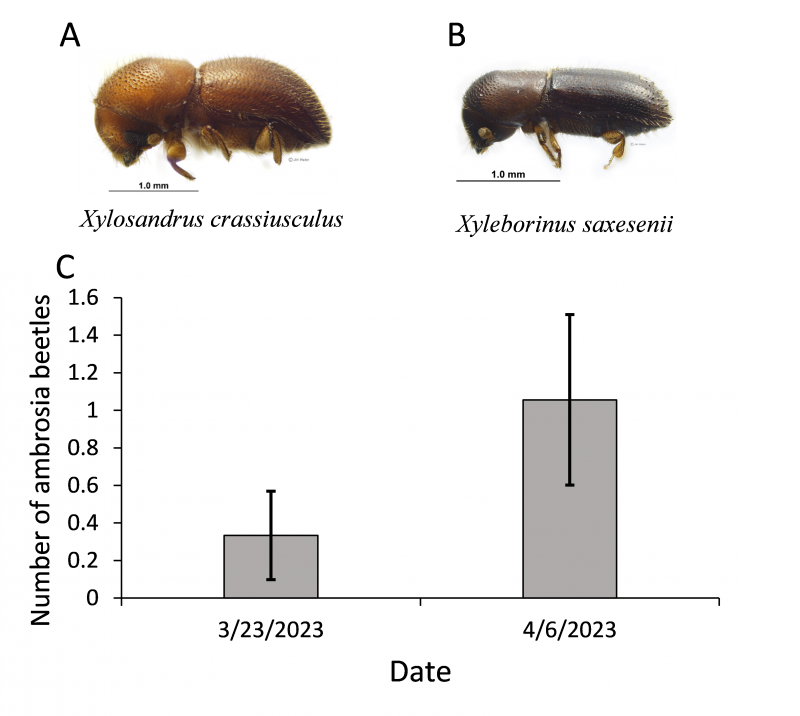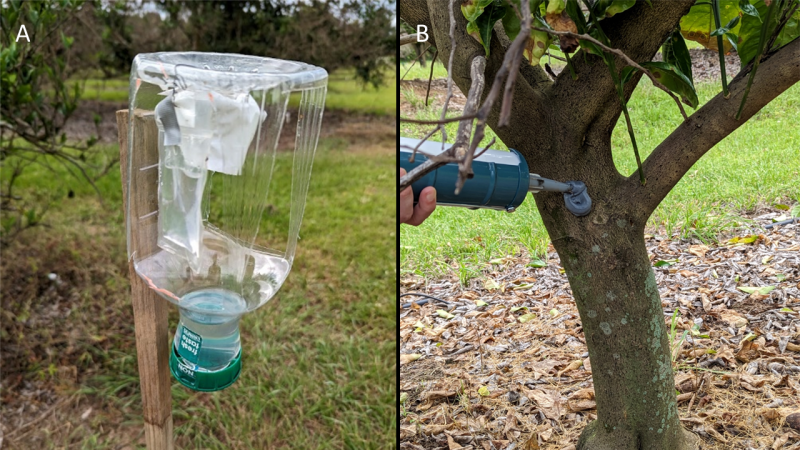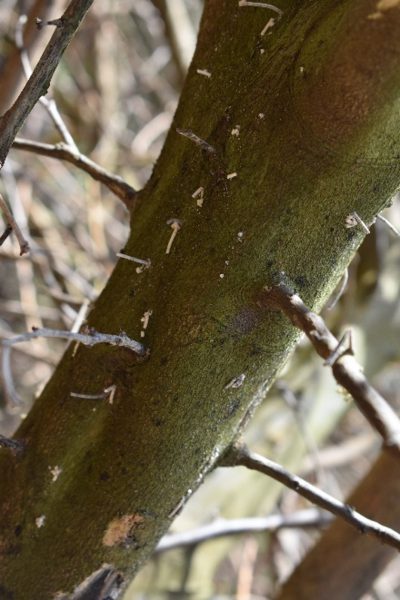Xavier Martini, Assistant Professor of Entomology, North Florida Research and Education Center, Derrick Conover,PhD Student and biological Scientist, Department of Entomology, North Florida Research and Education Center, and Danielle Williams,UF/IFAS Multi-County Commercial Horticulture Agent
The recent Winter Strom Elliott, that hit Florida last Christmas, has stressed a lot of our fruit trees, in particular citrus. When trees are stressed, they become the target of opportunistic pests such as ambrosia beetles.
Ambrosia beetles are a group of wood-boring insects that live in dead or severely stressed trees or dead wood and are all associated with a fungal symbiont that may accelerated the death of an infested tree. Typically, these beetles bore a hole into the xylem of the tree, where they excavate a gallery to feed and reproduce. They are attracted to the odor that the damaged and dead/dying trees give off, which is why you may be seeing them now in freeze damaged citrus trees. Once they locate a sick tree, they bore into the lower part of the tree (about 2-3 feet from the ground), creating a tunnel or a gallery. You will likely notice sawdust from the galleries at the base of the tree or you may notice a toothpick like protrusion of sawdust at the base of the gallery (Figure 1 right).
Few species of ambrosia beetles are considered true pests that attack living trees, but most species are pest that attack stressed, damaged, or dying trees. However, any stress such as freezing, flooding, drought, or other pathogens causes fruit trees to become attractive to ambrosia beetles.
Our team recently started a survey of ambrosia beetles in citrus in North Florida. We observed an increase in the capture number in April as compared to March (Fig. 2 below). The principal beetles found were Granulate Ambrosia Beetle (2A), Xylosandrus crassiusculus (32% of the beetles catch) and the Fruit-tree Pinhole Borer (2B) Xyleborinus saxesenii (27% of the beetle catch) (Fig. 2C). While the Granulate Ambrosia Beetle is a well-known ornamental and nursery pest that can be quite damaging, Fruit-tree Pinhole Borer is only a concern for stressed and damaged trees.

Figure 2: (A) Granulate Ambrosia Beetle (Xylosandrus crassiusculus) and (B) Fruit-tree Pinhole Borer (Xyleborinus saxesenii), the two ambrosia beetles most commonly found in citrus groves in North Florida in March and April 2023. Photo credits: Jiri Hulcr. (C) Mean number of ambrosia beetles per trap captured in citrus groves in North Florida.
–
To sample for ambrosia beetles, several options are possibles: a white sticky trap stapled directly to the first three feet of the trunk of the citrus tree will be efficient. Bottle trap (Fig. 3A) is also an option. Use a plastic bottle and cut two rectangular windows on the opposite sides. Hang the bottle to a stick upside down with the lid screw, and fill the bottom with ethanol, or use a pouch of ethanol lure, hang inside the bottle, and fill the bottom with soap water. Beetles will be attracted to the ethanol odor and are captured in the trap.
To control Ambrosia beetle, removing infested trees and properly disposing of them (chipping or burning) is a first line of defense. Also, a good preventive measure is the use of verbenone that is an anti-aggregate and repellent that has been proven to repel a wide range of ambrosia species. Verbenone is sold by different providers either as pouches to hang directly on the tree or as a SPLAT (SPLAT Verb®). SPLAT is a wax matrix that has slow releasing verbenone and has the advantage of being applied directly on the trunk. SPLAT or verbenone pouch should be applied on the first three feet of the trunk, where ambrosia beetle attacks are the more frequent. Usually, SPLAT is efficient up to 6 weeks, and four dollops of 2 inches diameter should be applied on trunk for good efficacy (Fig. 3B). It is recommended to apply the SPLAT only on trees that suffered the greatest damage from the freeze and are at risk of attack by the beetles.

Figure 3: Tools for ambrosia beetle management. (A) Trap bottle for ambrosia beetle collection. Note the ethanol pouch within the trap. (B) SPLAT Verb applied directly on the trunk.
–
Insecticidal treatments can also be used on infected trees to prevent attacks of ambrosia beetle. In avocado the recommended practice is to conduct two trunk and major limb direct applications (up to 10 ft height from the ground) at a 14-day interval of a registered contact insecticide (such as pyrethroids) to healthy trees within a 1-acre area of any ambrosia beetle infected trees.
Finally, since ambrosia beetles are attracted to stressed trees, the best defense is to promote tree health by optimizing fertilizer and irrigation practices.
- Sap Beetles are Not a Cause of Concern for Citrus but Katydids Are - October 4, 2024
- The Importance of Pollination for Seedless Watermelons and How to Enhance it - April 5, 2024
- New Perspectives for the Management of Invasive Air Potato Vine - November 17, 2023

